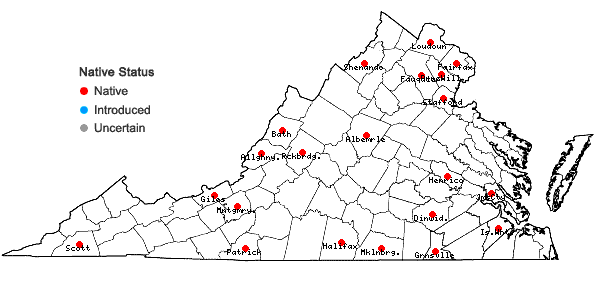Fraxinus biltmoreana Beadle
No images available.

Show image without county labels
Detail
- Family
- Oleaceae
- Botanical Name
- Fraxinus biltmoreana Beadle
- Common Name
- Biltmore Ash, Biltmore White Ash
- Synonym(s)
- Fraxinus biltmoreana Beadle var. biltmoreana (Beadle) Wright ex Fern.; Fraxinus smallii Britt.
- Flora of Virginia Name/Status
- Fraxinus biltmoreana Beadle
- Comments
- Over the years, this taxon has been variously recognized as a species, a variety, or a mere form of F. americana. It has sparsely to densely pubescent twigs, petioles, petiolules, and rachises plus generally larger fruits (samaras 33-54 × 6-8 mm; bodies [7-]11-15 × 2-4 mm). The leaf scars of F. biltmoreana also have a nearly truncate apex as opposed to the V-, U-, or crescent-shaped upper margins found in true F. americana. Nesom (2010, Phytoneuron 2010-51: 1-30), points to chromosome counts made by other workers which seem to establish F. americana as a diploid and F. biltmoreana as a hexaploid; this difference in ploidy level, in combination with morphological differences, led Nesom to conclude that these taxa should be treated as species. He also resurrected the little-used name Fraxinus smallii for a tetraploid with glabrous twigs, petioles, petiolules, and rachises, samaras (32-)36-44 × (4.5-)5-7 mm, and bodies (9-)10-13 × 2-3.5 mm. In a later, extensive study of ploidy levels involving all 12 native Fraxinus spp. by Whittemore et al. (2018, Int. J. Plant Sci. 179(5): 377-389), results "strongly supported" the taxonomic separation of polyploid F. biltmoreana and diploid F. americana.
In Virginia, field and herbarium experience with specimens that appear to be intermediate has been confusing. Moreover, pubescent forms also often have buds more like F. pennsylvanica, causing additional confusion. However, aligning allopolyploids with one of their parents infraspecifically does not make sense. According to Nesom (2014), "Fraxinus smallii (tetraploid) and F. biltmoreana (hexaploid) presumably include the genome of diploid F. americana and it is reasonable to speculate that their extra chromosome sets were acquired via hybridization with forms of F. pennsylvanica or some other species of green ash." This could account for much of the variation in pubescence, as well as the similarities of bud and leaf scars with those of F. pennsylvanica, that have been observed in Virginia specimens. Campbell's paper (2017, Phytoneuron 2017-28: 1-36) on sect. Melioides provides further support for according F. biltmoreana species rank.
The status in Virginia of Fraxinus smallii, a tetraploid, is very uncertain, as is its appropriate taxonomic treatment. Given the opinions of Whittemore et al. (2018) and Campbell (2017) that this taxon does not merit species status, we are treating F. smallii in synonymy under F. biltmoreana until further studies clarify its disposition. - Habitat
- Bottomlands, mesic slope forests, rocky bluffs and woodlands. The map is no doubt very incomplete due to past lumping of Fraxinus biltmoreana in Virginia floristic studies. However, it is apparently widely distributed, at least in the mountains and Piedmont, although extensive field and herbarium work will be needed to fully flesh out the Virginia distribution. All Fraxinus species are currently in decline and suffering extensive mortality from state-wide outbreaks of the introduced insect pathogen, Emerald Ash Borer (Agrilus planipennis).
- Native Status
- Native
To save this map, right-click (control-click for Mac users) on the map and choose "Save Image As...".